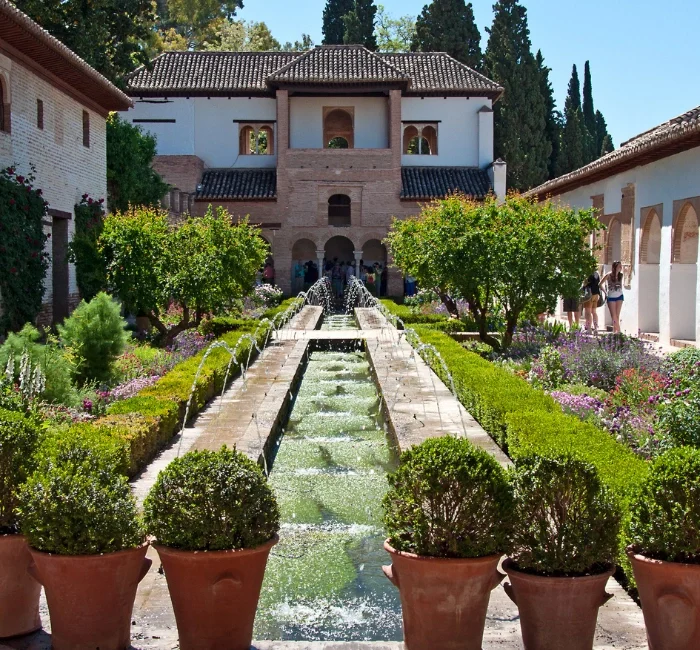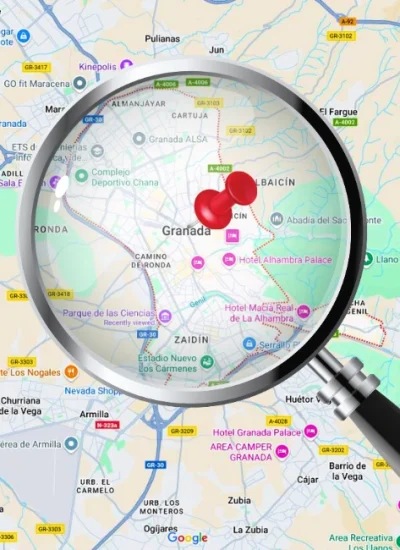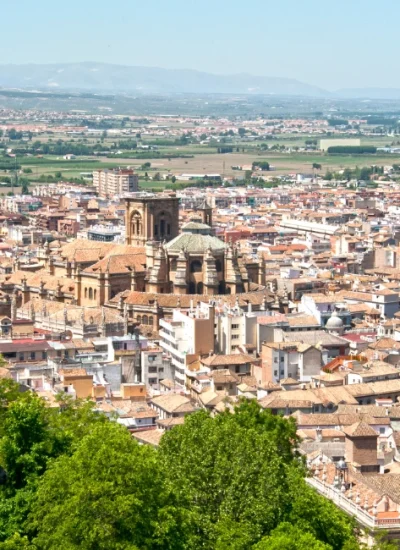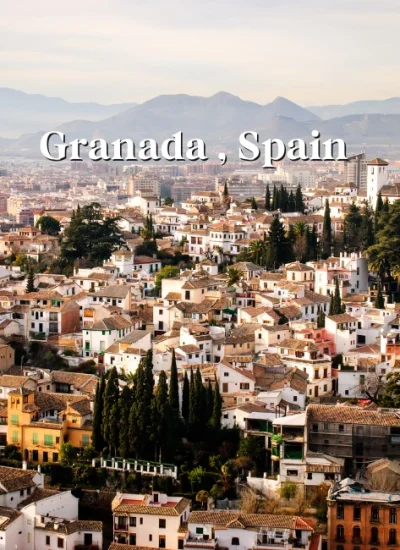When planning your visit, you’ll quickly discover that things to do in Granada, Spain, are as diverse as they are captivating.
Nestled in the heart of Southern Spain, Granada is a vibrant city where Moorish architecture meets Renaissance splendor, creating a rich tapestry of history and culture.
From exploring the majestic Alhambra to wandering through the narrow streets of the Albayzín, this guide will take you through the top 10 must-see sights and experiences in Granada.
Whether you’re drawn to the city’s stunning landscapes, its cultural heritage, or its delectable cuisine, this itinerary offers a perfect blend of history, nature, and local flavors, ensuring your time in Granada is nothing short of unforgettable.
For more detailed travel tips and recommendations, be sure to explore our Ultimate Guide to Things to Do in Granada, Spain.
1. Majestic Alhambra Palace
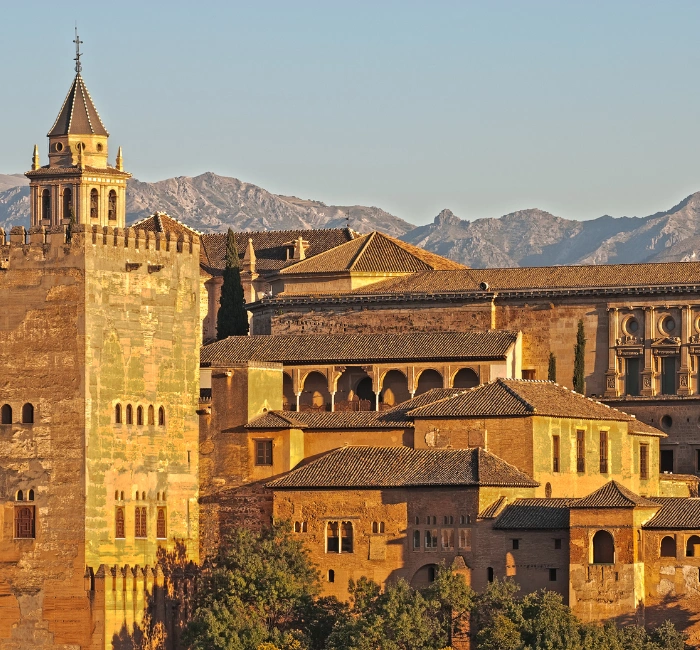
When planning things to do in Granada, Spain, the Alhambra Palace is undoubtedly at the top of the list. As the crown jewel of Granada, this UNESCO World Heritage Site is a stunning example of Moorish architecture and a symbol of the Nasrid Dynasty.
A Glimpse into History
The Alhambra Palace stands as a testament to the grandeur of the Nasrid Dynasty, with its construction beginning in the mid-13th century. The palace complex served as a royal residence, fortress, and the center of political power for the last Muslim dynasty in Southern Spain. Its intricate stucco work, vibrant tiles, and delicate Moorish architecture reflect the artistry of its time.
Nasrid Palaces, Generalife Gardens, and Alcazaba
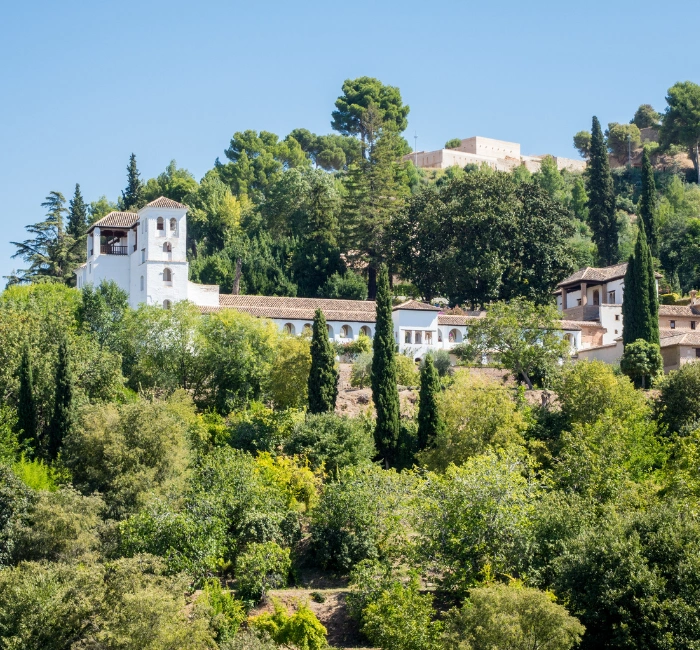
Your visit to the Alhambra includes exploring the Nasrid Palaces, Generalife Gardens, and Alcazaba:
Nasrid Palaces: These palaces are the heart of the Alhambra, featuring rooms like the Hall of the Ambassadors and the Court of the Lions, known for their elaborate decoration and historical significance.
Generalife Gardens: Adjacent to the Alhambra, these gardens were the summer palace for the Nasrid rulers. The Generalife Gardens offer a peaceful retreat with lush greenery and spectacular views of Granada.
Alcazaba: The oldest part of the Alhambra, this fortress provides panoramic views of Granada and the Sierra Nevada Mountains. It’s a must-see for anyone visiting the Alhambra.
Tips for Visiting the Alhambra
Purchase Alhambra Tickets in Advance: Tickets often sell out, so it’s essential to book ahead, especially for peak tourist seasons.
Best Times to Visit: Early morning or late afternoon visits are ideal to avoid crowds and enjoy the serene atmosphere.
What to Bring: Comfortable walking shoes, a camera for capturing the stunning Granada sights, and water to stay hydrated.
Local Guide Recommendations: Consider hiring a local guide to enrich your understanding of the Alhambra’s history and architecture.
2. Albayzín (Moorish Quarter)
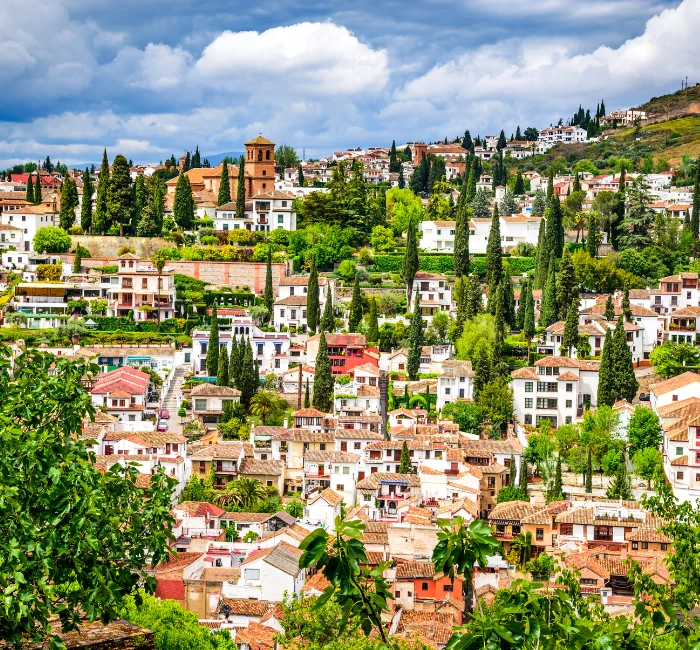
Just a short walk from the Alhambra lies the Albayzín, Granada’s historic Moorish Quarter. This district is a UNESCO World Heritage Site known for its whitewashed buildings, winding streets, and rich cultural heritage.
Albayzín: Granada’s Historic Heart
The Albayzín is one of the oldest neighborhoods in Granada, dating back to the Islamic period. Its narrow, winding streets are lined with whitewashed houses that harken back to a bygone era. As you explore, you’ll encounter hidden plazas, traditional Moorish architecture, and some of the best views in Southern Spain.
Mirador de San Nicolás: Breathtaking Views
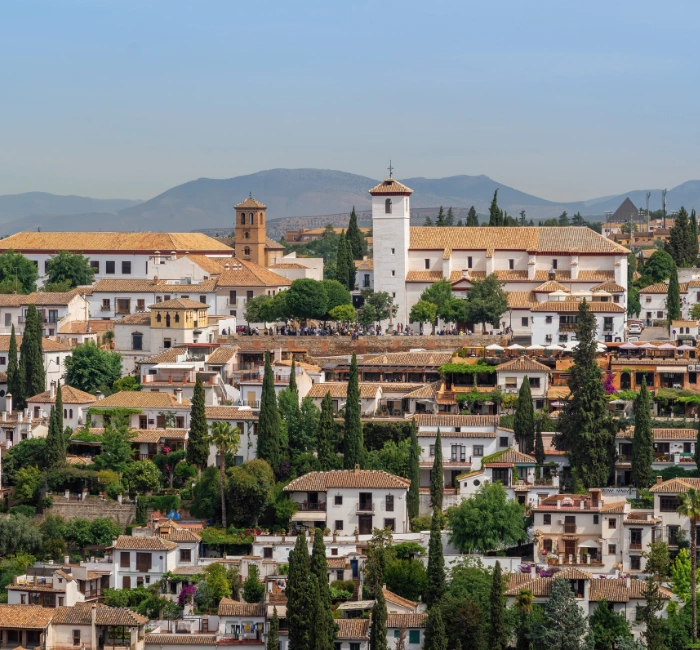
A highlight of any visit to the Albayzín is the Mirador de San Nicolás, located just a short walk from Plaza de San Nicolás. This famous viewpoint offers absolutely stunning views of the Alhambra Palace, with the mountains serving as a majestic backdrop. The Mirador de San Nicolás is particularly popular at sunset, when the warm light bathes the Alhambra in a golden glow, creating a picture-perfect moment at Plaza de San Nicolás.
Cultural Heritage and Dining in the Albayzín
The Albayzín is not just about the views. It’s also about the experience. The neighborhood, especially around Plaza de San Nicolás, is home to several tapas bars and local cafés where you can sample traditional Granada cuisine, including tinto de verano and churros con chocolate.”
Exploring the Albayzín is like stepping back in time. Its Moorish architecture, coupled with the vibrant local culture, makes it one of the most worth visiting areas in Granada.
3. Granada Cathedral and the Royal Chapel
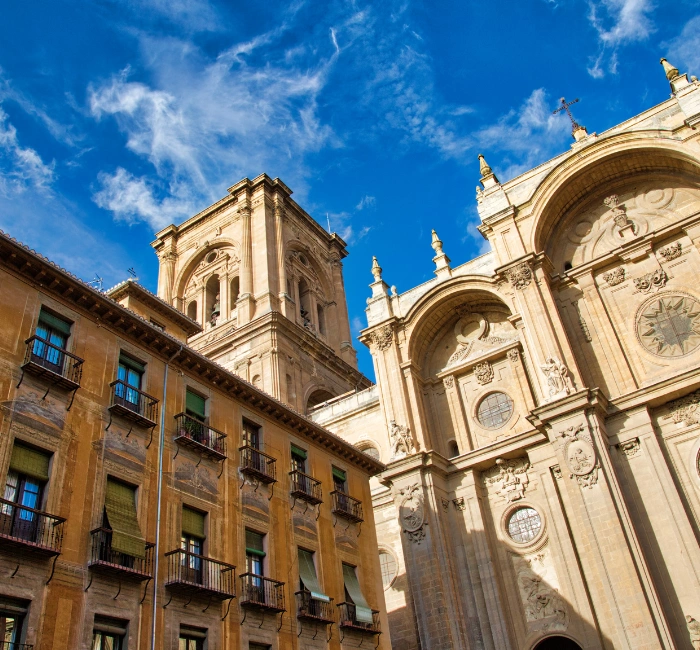
The Cathedral of the Incarnation is an architectural marvel that took nearly two centuries to complete. Construction began in 1523 on the site of a former mosque, symbolizing the city’s transition from Islamic to Christian rule following the Reconquista. As you approach the cathedral, you’ll be struck by its grand façade, characterized by towering columns and intricate carvings that showcase the grandeur of Renaissance architecture.
Inside, the cathedral’s vast, light-filled interior is just as impressive. The high vaulted ceilings, expansive chapels, and stunning altarpieces create a space that is both awe-inspiring and serene. The Main Chapel is a particular highlight, featuring a grandiose altar surrounded by massive pillars and adorned with gold accents. The cathedral’s design reflects a blend of Gothic and Renaissance styles, with a strong emphasis on symmetry and proportion, hallmarks of Renaissance art.
The Royal Chapel: A Monument to Spain’s Catholic Monarchs
Adjacent to the cathedral is the Royal Chapel, the final resting place of two of Spain’s most revered figures: Queen Isabella I and King Ferdinand II. These monarchs, known as the Catholic Monarchs, were instrumental in unifying Spain and completing the Reconquista, which ended with the fall of Granada in 1492.
The Royal Chapel is more than just a burial site; it is a monument to the Catholic Monarchs’ legacy and their role in shaping the history of Spain. The chapel’s interior is richly decorated with Renaissance and Gothic elements, including intricate sculptures, tapestries, and the magnificent tombs of Isabella and Ferdinand, crafted from white Carrara marble. Visiting the Royal Chapel offers a profound connection to Spain’s history, as you stand in the presence of the monarchs who played a pivotal role in its past.
A Journey Through History and Culture
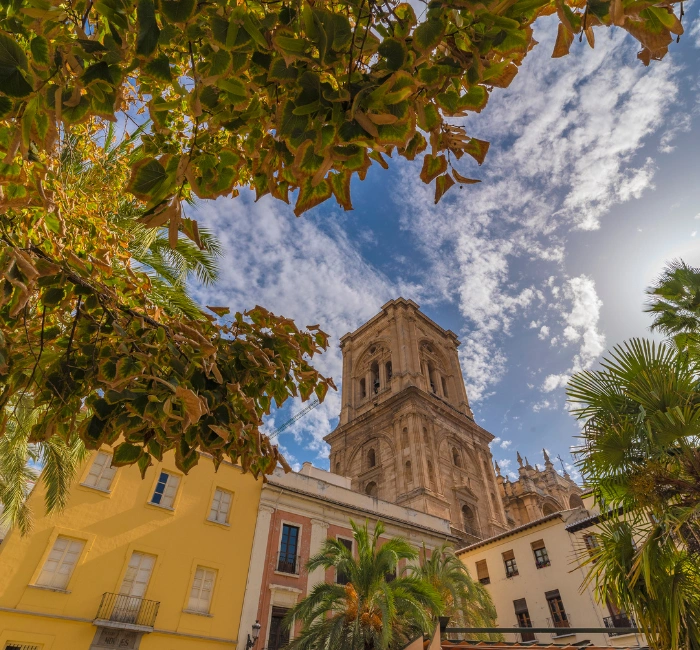
Visiting the Granada Cathedral and Royal Chapel is more than just a tour of beautiful architecture. It’s a journey through the history and culture of Granada and Spain. As you walk through these sacred spaces, you’ll gain a deeper appreciation for the city’s rich heritage and the significant role it played in the broader context of Spanish history.
Local Cuisine and Nearby Cafés
After exploring these historical treasures, take some time to enjoy the vibrant atmosphere of Granada’s city center, where some of the best hotels in Granada offer convenient access to these iconic sites. The area around the cathedral is filled with charming cafés and restaurants where you can savor local cuisine. Whether you’re in the mood for a traditional tapas experience or a refreshing tinto de verano, there’s no better way to end your visit than by indulging in the flavors of Southern Spain.
4. Paseo de los Tristes and Carrera del Darro
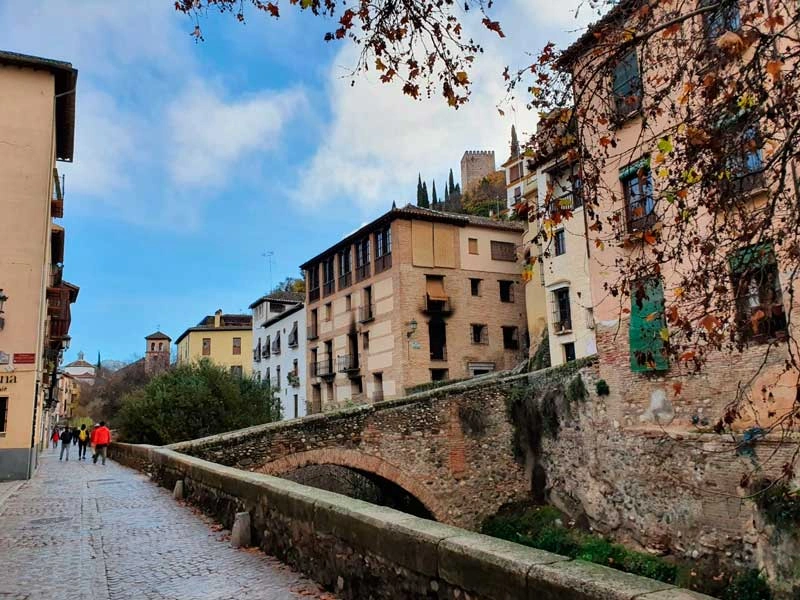
For a more leisurely exploration of Granada, one of the must-do things to do in Granada, Spain, is a stroll along the Carrera del Darro. This picturesque path offers some of the most stunning views of the Alhambra Palace and a glimpse into the city’s Moorish past.
Carrera del Darro: A Scenic Stroll
The Carrera del Darro, officially known as the Paseo del Padre Manjón, is one of the most scenic walks in Granada. This charming walkway runs along the Darro River, offering absolutely stunning views of the Alhambra as it rises above the trees. The name “Walk of the Sad Ones,” which translates from “Paseo de los Tristes,” dates back to the route’s historical use for funeral processions. However, today it is a lively area filled with tourist groups, locals, and street performers.
As you walk along the Carrera del Darro, you’ll be surrounded by the natural beauty of the Darro River and the historical charm of the Moorish Quarter. The pathway is lined with traditional tapas bars and cafés, making it the perfect place to pause and enjoy some churros con chocolate or tinto de verano while soaking in the atmosphere.
Carrera del Darro: Granada’s Historic Street
Just a few minutes from the Paseo de los Tristes, the Carrera del Darro is one of Granada’s oldest and most picturesque streets. This narrow, cobblestone road runs alongside the Darro River and is flanked by ancient buildings that showcase the city’s Moorish architecture. Walking along the Carrera del Darro feels like stepping back in time, with the Alhambra’s towers peeking out from behind every corner.
One of the highlights of this area is the Arab Baths or El Bañuelo, one of the best-preserved Moorish baths in Spain. Visiting El Bañuelo offers a unique opportunity to connect with Granada’s Moorish heritage and understand the importance of these baths in daily life during the Moorish period.
Local Cafés and Refreshing Stops
As you explore the Carrera del Darro, take the time to stop at one of the many local cafés for a refreshing break. Whether you’re a huge fan of leisurely strolls or simply taking in the view, these stops offer a chance to relax and absorb the beauty of your surroundings.
Exploring the Carrera del Darro is one of the top attractions in Granada, offering a perfect blend of history, culture, and natural beauty. It’s a journey through the city’s historical center that allows you to experience the essence of Granada at a leisurely pace.
5. Granada’s Nightlife with Flamenco
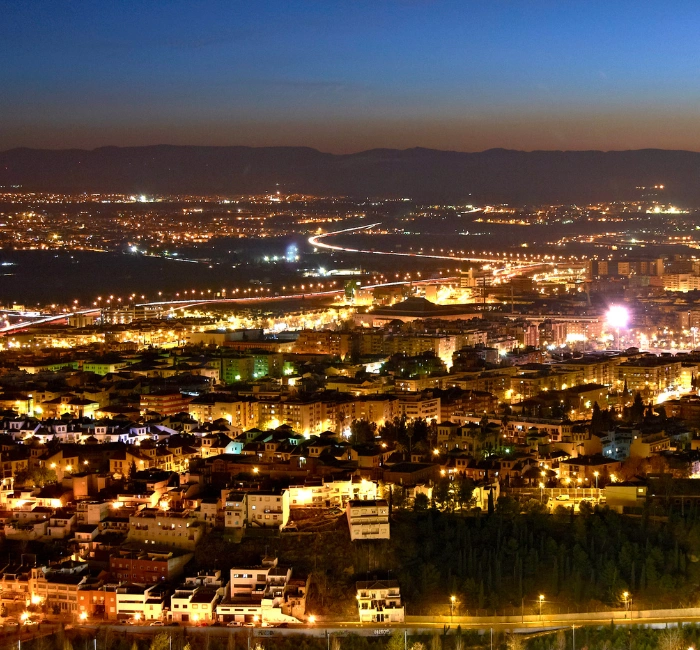
When the sun sets over Granada, Spain, the city comes alive with the passionate rhythms of flamenco, a quintessential part of Andalusian culture. One of the most iconic things to do in Granada, Spain, is attending a flamenco show, which offers more than just an evening of entertainment. It’s a deep dive into the soul of Andalusia, where music, dance, and emotion blend into a powerful, unforgettable experience.
Flamenco Show: The Soul of Andalusia
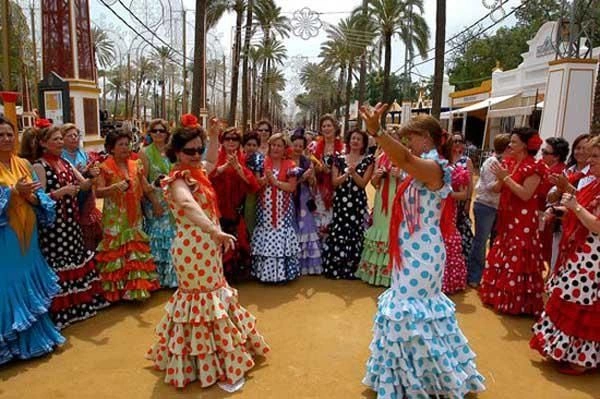
Credit:puelalunaris
Flamenco is more than just a performance. It’s an art form deeply rooted in the history and culture of Southern Spain. Originating from the gypsy communities of Andalusia, flamenco combines Spanish music, passionate dance, and profound emotion to tell stories of love, sorrow, and joy. The art form has been recognized as an Intangible Cultural Heritage of Humanity by UNESCO, a testament to its cultural significance.
In Granada, one of the best places to experience authentic flamenco is in the Sacromonte caves. These caves, located along the Camino del Sacromonte in the Sacromonte district, have been home to the city’s gypsy community for centuries and are the birthplace of some of the most famous flamenco artists.
Watching one of the authentic flamenco performances in these caves offers a raw, intimate experience, where the proximity to the performers allows you to feel every beat, every clap, and every cry of the cante jondo (deep song)
Top Flamenco Venues in Granada

Credit:powertraveller
For those looking to experience the best of Granada’s flamenco scene, here are some top venues to consider:
Jardines de Zoraya: Located in the historic Albayzín neighborhood, this venue offers dinner and a show, allowing you to enjoy Andalusian cuisine while being mesmerized by the flamenco performers. The atmosphere is intimate, and the performances are both powerful and passionate.
Zambra María la Canastera: Situated in the Sacromonte caves, this venue is one of the most traditional places to watch flamenco in Granada. The performers are often descendants of famous flamenco families, and the show is a deep, authentic experience.
La Alboreá: Situated right in Plaza Nueva, this venue is known for its high-quality performances and professional dancers, making it a convenient stop after exploring the nearby attractions. It’s an excellent choice if you’re staying in the city center and want to experience flamenco without venturing far.
Post-Show Dining and Drinks
After immersing yourself in the emotional intensity of a flamenco show, continue your evening with a visit to one of the many tapas bars around Plaza Nueva, where you can soak in the lively atmosphere. The Sacromonte and Albayzín districts are home to some of the city’s best spots for tapas, where you can enjoy tinto de verano, churros con chocolate, and other local delicacies.
Calle Elvira is a popular street lined with tapas bars where locals and tourists alike gather to unwind after a night of flamenco. Los Diamantes is another favorite, known for its fresh seafood tapas and lively atmosphere. Whether you’re looking for a quiet spot to reflect on the evening or a bustling bar to keep the night going, Granada’s culinary scene has something to offer.
6. Granada’s Culinary Scene

No visit to Granada is complete without indulging in the city’s vibrant culinary scene, where food is not just a meal but a way of life. From the bustling markets to the cozy tapas bars, Granada offers a culinary journey that reflects the rich history and diverse cultural influences of Southern Spain.
Tapas and Local Cuisine
Granada is renowned for its unique tapas tradition, where each drink is accompanied by a complimentary small plate of food. This tradition makes it easy to sample a wide variety of dishes, from jamón serrano to patatas bravas, without committing to a full meal. Tapas are not just about the food—they’re about the experience of sharing, socializing, and savoring the moment.
Some must-try dishes include:
Churros con Chocolate: A sweet treat perfect for breakfast or a late-night snack. These deep-fried dough pastries are served with thick, rich chocolate for dipping.
Tinto de Verano: A refreshing blend of red wine and lemon soda, this popular summer drink is often sipped during the early afternoon or paired with tapas for a light, cooling experience.
Gazpacho: A cold tomato soup that’s refreshing on a hot day, often served as a starter in many of Granada’s restaurants.
Best Tapas Bars and Markets
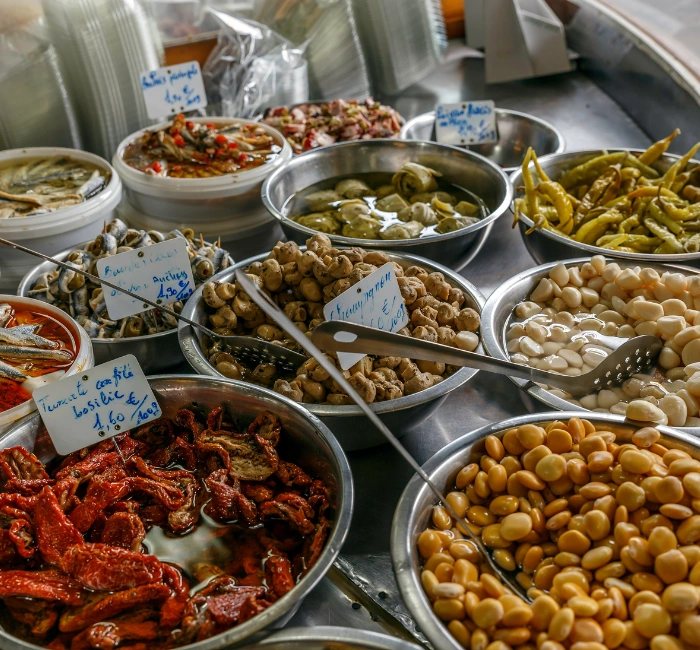
To experience the best of Granada’s tapas culture, here are some recommended spots:
Bodegas Castañeda: Situated in Plaza Nueva, this is one of Granada’s most famous tapas bars, known for its traditional Andalusian dishes and vibrant atmosphere.
Bar Los Diamantes: A popular spot for seafood lovers, this bar is famous for its fried fish tapas and bustling environment.
Calle Navas: A street lined with tapas bars, perfect for a tapas crawl where you can hop from one bar to the next, sampling different dishes at each stop.
For a deeper dive into Granada’s culinary offerings, consider visiting one of the city’s local markets, such as the Mercado San Agustín. Here, you can find fresh produce, local meats, and artisanal products that give you a true taste of the region.
Cooking Classes and Culinary Tours
If you’re looking to take a piece of Granada home with you, why not learn how to make some of the dishes yourself? Granada offers several cooking classes where you can learn to prepare traditional Andalusian cuisine. These classes often include a trip to the market to select fresh ingredients, followed by a hands-on cooking session where you can learn the secrets of dishes like paella or salmorejo.
7. Relax at the Hammam Al Ándalus (Arab Baths)
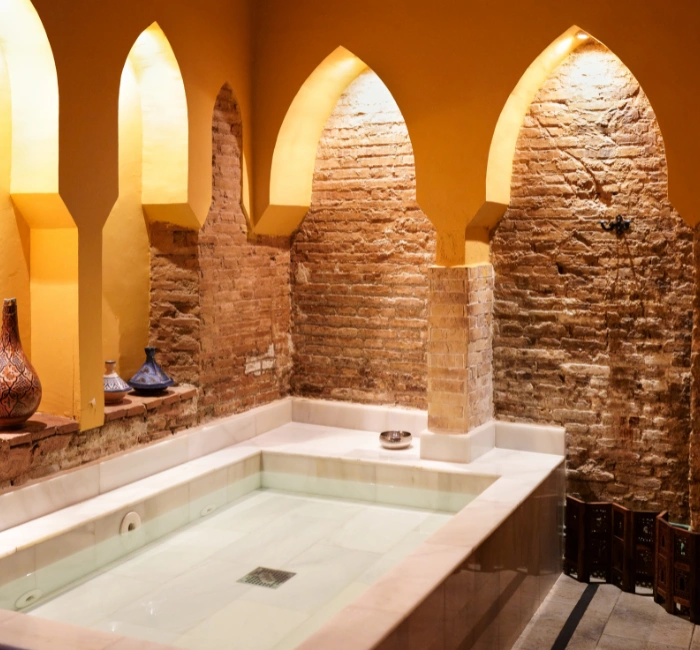
In the heart of Granada, nestled within the city’s historic center, lies the Hammam Al Ándalus, a sanctuary of relaxation and an echo of the city’s Moorish past. Visiting the Hammam Al Ándalus is more than just a spa experience; it’s a journey back in time to the days when the Moorish architecture dominated Granada’s cityscape, and public baths were central to social life.
Hammam Al Ándalus: A Tradition of Relaxation
The Hammam Al Ándalus is a recreation of the traditional Arab baths that were once common throughout Southern Spain. These baths played a significant role in Moorish culture, serving not only as places for cleansing the human body but also as centers for social interaction and relaxation. The Hammam Al Ándalus has preserved this tradition, offering visitors a serene environment where the stresses of modern life melt away.
The bathhouse is designed to reflect the grandeur of Moorish architecture, with intricate tilework, archways, and dimly lit spaces that create a tranquil and intimate atmosphere. The soft lighting, combined with the gentle sounds of water and the soothing scents of essential oils, makes for an immersive experience that engages all the senses.
Ambiance and Services
The Hammam Al Ándalus offers a variety of services, including traditional baths, massages, and body treatments, some of which may come at an extra cost. The baths are divided into different temperature zones, from the warm tepidarium to the hot caldarium and the cool frigidarium, allowing you to move through the different areas at your own pace. The contrast between the hot and cold baths is invigorating, helping to improve circulation and relax the muscles.
One of the highlights of the Hammam Al Ándalus experience is the kessa massage, a traditional exfoliation treatment that leaves your skin feeling refreshed and rejuvenated. You can also indulge in a relaxing massage with essential oils, designed to ease tension and enhance your overall sense of well-being.
Tips for Making the Most of Your Visit
Book in Advance: The Hammam Al Ándalus is a popular attraction, so it’s advisable to book your session in advance to ensure availability.
Choose the Right Time: For a more peaceful experience, consider visiting in the early afternoon or late evening when it’s less crowded.
What to Bring: The hammam provides all the necessary amenities, including towels and slippers, but you may want to bring a swimsuit if you prefer.
Relax and Unwind: Take your time moving through the different baths, and don’t forget to hydrate with the herbal teas offered in the relaxation area.
Visiting the Hammam Al Ándalus is one of the top attractions in Granada and an essential experience for those looking to connect with the city’s Moorish heritage. It’s a perfect way to relax after a day of exploring the Granada sights and immerse yourself in the rich cultural tapestry of the region.
8. Sierra Nevada Mountains
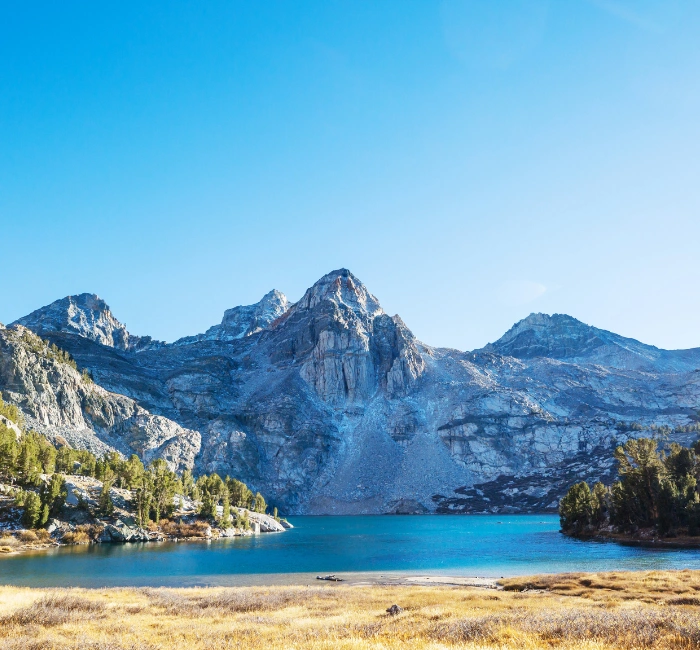
Beyond the historical and cultural richness of Granada lies the breathtaking natural beauty of the Sierra Nevada Mountains. Just a short drive from the city center, the Sierra Nevada offers a stunning contrast to the urban landscape, with its rugged peaks, serene valleys, and diverse wildlife. A day trip to the Sierra Nevada National Park is one of the most worth visiting experiences, whether you’re seeking adventure or tranquility.
Day Trip to Sierra Nevada National Park
The Sierra Nevada National Park is a vast protected area that encompasses some of the highest peaks in mainland Spain, including Mulhacén and Veleta. The park is a haven for outdoor enthusiasts, offering a range of activities throughout the year.
Hiking and Nature Walks: During the warmer months, the Sierra Nevada is a paradise for hikers and nature lovers. The park boasts a network of trails that cater to all levels, from gentle walks to challenging treks. One of the most popular routes is the Vereda de la Estrella, which offers breathtaking views of the surrounding mountains and valleys. For those seeking a more leisurely experience, there are plenty of shorter trails that provide opportunities to explore the park’s diverse flora and fauna.
Winter Sports: In the winter, the Sierra Nevada transforms into a snowy wonderland, attracting skiers and snowboarders from across Europe. The Sierra Nevada Ski Resort is one of the most popular in Southern Spain, offering well-groomed slopes for all skill levels, as well as stunning views of the Mediterranean Sea on clear days. Even if you’re not into skiing, a visit to the resort is worth it for the scenic beauty alone.
Scenic Lunch in the Alpujarras
On your way back to Granada, a stop in the Alpujarras region is highly recommended. This area, located on the southern slopes of the Sierra Nevada, is known for its picturesque villages, terraced farmlands, and traditional Andalusian architecture.
The Alpujarras is also famous for its local cuisine, making it the perfect place to enjoy a scenic lunch. Many of the villages have restaurants that serve hearty, traditional dishes made from locally sourced ingredients. Whether you choose a rustic tavern or a charming café with mountain views, the Alpujarras offers a unique dining experience that complements your day of adventure.
Visiting the Sierra Nevada National Park and the Alpujarras is an opportunity to connect with the natural beauty of Andalusia and experience a side of Granada that is often overlooked by visitors. Whether you’re hiking through wildflower-filled meadows or savoring a meal in a mountain village, this day trip promises to be a highlight of your visit to Granada.
9. Monasterio de San Jerónimo
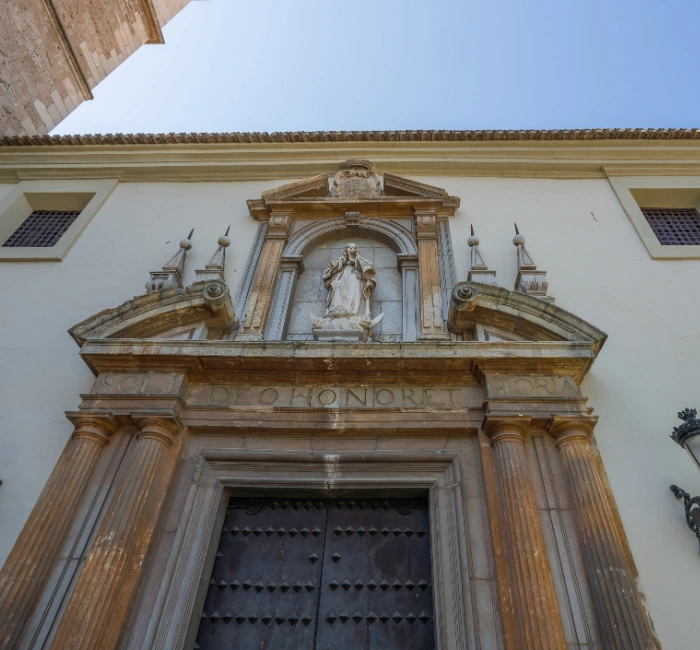
If you’re looking to delve into Granada’s rich religious history, the Monasterio de San Jerónimo is a hidden gem that should not be missed. This historic monastery, located near the city center, is a masterpiece of Renaissance architecture and offers a peaceful retreat from the bustling city.
Monasterio de San Jerónimo: A Hidden Gem
The Monasterio de San Jerónimo was founded in the early 16th century and stands as a testament to Granada’s transition from Moorish to Christian rule. The monastery is renowned for its beautiful church and cloisters, which are considered some of the finest examples of Renaissance architecture in Southern Spain.
Exploring the Monastery: As you enter the monastery, you’ll be struck by the grandeur of its architecture. The church features a stunning altarpiece, intricately carved from wood and gilded in gold, depicting scenes from the life of Jesus Christ. The cloisters are equally impressive, with their serene courtyards surrounded by arched walkways, offering a tranquil space for reflection.
Historical Significance: The Monasterio de San Jerónimo played a crucial role in Granada’s religious heritage. It was one of the first Christian buildings constructed after the Reconquista, symbolizing the city’s new Christian identity. The monastery also served as a burial place for prominent figures, including the great military leader Gonzalo Fernández de Córdoba, known as El Gran Capitán.
Visiting Tips and Recommendations
Peaceful Atmosphere: The monastery is known for its peaceful atmosphere, making it an ideal place to escape the hustle and bustle of Granada. Take your time exploring the cloisters and gardens, and don’t miss the chance to sit in quiet contemplation in the church.
Cafés and Light Meals: After your visit, enjoy a light meal or a coffee at one of the nearby cafés. The area around the monastery is less touristy, offering a more authentic experience of Granada’s local culture.
The Monasterio de San Jerónimo is not just a site for religious visitors or history buffs. It’s a place where you can connect with the deeper spiritual and cultural layers of Granada. Whether you’re drawn by the Renaissance art, the peaceful ambiance, or the rich history, a visit to this monastery will enrich your understanding of Granada’s past.
10. Parque de las Ciencias
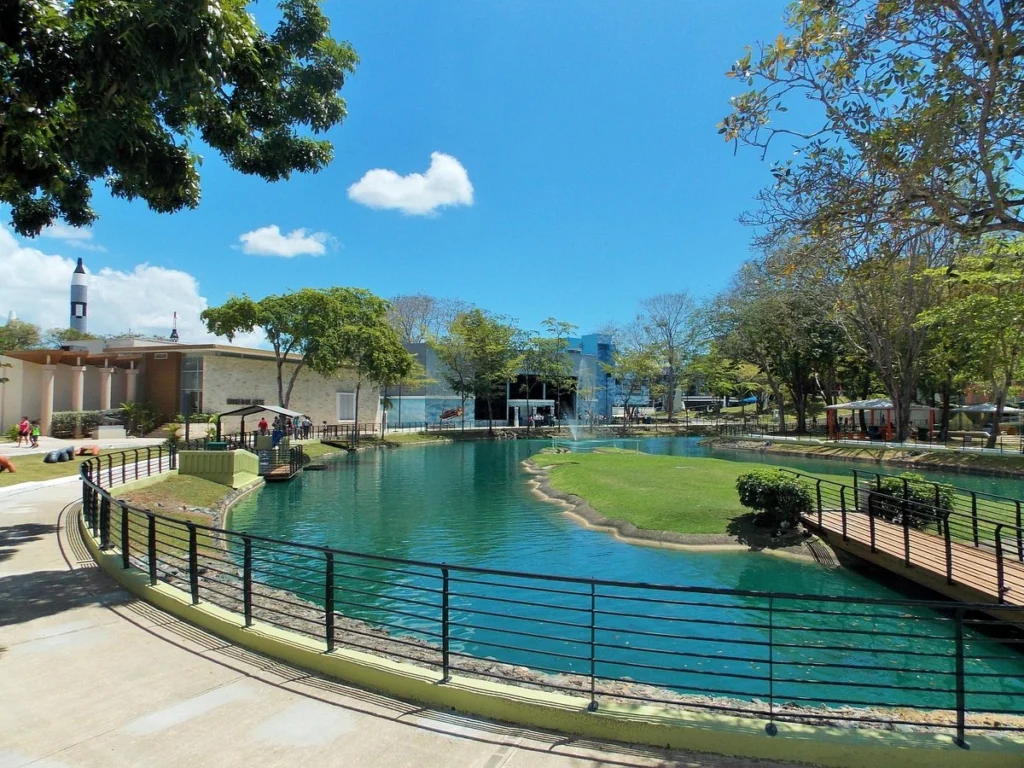
Parque de las Ciencias in Granada is more than just a museum. It’s an immersive experience that blends education with fun, making it one of the top things to do in Granada, Spain for visitors of all ages. Located just a short distance from the city center, this interactive science museum offers a day of discovery that is both engaging and enlightening.
Parque de las Ciencias: A Day of Learning and Fun
The Parque de las Ciencias is Granada’s premier science museum, and it stands out as one of the most visited in Southern Spain. Spanning over 70,000 square meters, the museum is home to a wide range of exhibits that cover various fields of science, technology, and the natural world. This makes it an ideal destination for families, students, and anyone with a curiosity for learning.
Interactive Exhibits: One of the highlights of Parque de las Ciencias is its hands-on approach to learning. The museum’s interactive exhibits invite visitors to engage directly with the concepts being presented, whether it’s through experimenting with physics in the Hall of Perception, exploring the intricacies of the human body in the Biosphere Pavilion, or discovering the wonders of the universe in the Planetarium. Each exhibit is designed to be both educational and entertaining, making science accessible and fun.
Outdoor Spaces: Beyond the indoor exhibits, Parque de las Ciencias also boasts beautiful outdoor areas. The Observation Tower offers panoramic views of Granada and the Sierra Nevada Mountains, providing a perfect backdrop for photos. The Botanical Garden is another must-visit, showcasing a variety of plant species from the Andalusia region. The garden’s serene environment is ideal for a leisurely stroll or a moment of relaxation amidst the museum’s activities.
Butterfly House: The Butterfly House is a favorite among visitors, especially families. This tropical greenhouse is home to hundreds of butterfly species, where you can observe them up close as they flutter around, adding a magical touch to your visit.
Relaxing Break at the Museum’s Cafés
After a few hours of exploring the museum, take a break at one of the Parque de las Ciencias’ on-site cafés. These cafés offer a selection of light meals, snacks, and drinks, allowing you to recharge before continuing your adventure. Whether you’re enjoying a coffee in the courtyard or savoring a traditional tinto de verano, the cafés provide a comfortable setting to relax and reflect on the day’s discoveries.
Visiting Parque de las Ciencias is not just about learning. It’s about inspiring curiosity and making science fun. Whether you’re traveling with children or exploring on your own, this museum offers a diverse range of experiences that cater to all interests. It’s a day well spent in Granada, combining education, entertainment, and a bit of relaxation, making it an essential part of your visit to this vibrant city.
Conclusion
As you wrap up your journey through Granada, it’s clear that this city is a treasure trove of unforgettable experiences. From exploring the architectural wonders of the Alhambra Palace and Granada Cathedral to immersing yourself in the vibrant culture of flamenco shows and tapas bars, the top 10 things to do in Granada, Spain, offer something for every traveler.
Whether you’re hiking in the Sierra Nevada Mountains, strolling along the Carrera del Darro, or simply soaking in the views from Mirador de San Nicolás, Granada’s diverse range of activities ensures a well-rounded and enriching visit.
Even if it’s your first time or a return trip, when you visit Granada, you’ll find it stands out as a must-visit destination in Southern Spain, blending history, culture, and natural beauty into a captivating experience. The city’s Moorish architecture, combined with its Renaissance heritage, provides a unique backdrop for your adventures, making every moment in Granada both exciting and memorable.
Additional Tips for Visitors
Extend Your Stay: If time permits, consider extending your stay to explore more of Granada’s hidden gems, such as the Sacromonte Abbey or a day trip to the Alpujarras.
Seasonal Tips: For those interested in skiing or snowboarding, visiting in winter offers the best conditions in the Sierra Nevada Ski Resort. Spring and early autumn are ideal for hiking and exploring the city’s historical sites without the summer crowds.
Customize Your Itinerary: Whether you’re a history buff, a nature lover, or a foodie, customize your itinerary to include activities that best match your interests. For instance, adding a flamenco performance at Jardines de Zoraya or a visit to the Arab Baths for a relaxing end to your day
For more in-depth information on specific attractions, restaurants, and travel tips, check out our detailed guides:
How to Visit the Alhambra: Tickets, Tours, and What to Expect
A Food Lover’s Guide to Granada: Best Tapas Bars and Local Dishes
Best Hotels in Granada: Where to Stay for Comfort and Style
Outdoor Adventures in Sierra Nevada: Hiking, Skiing, and More
